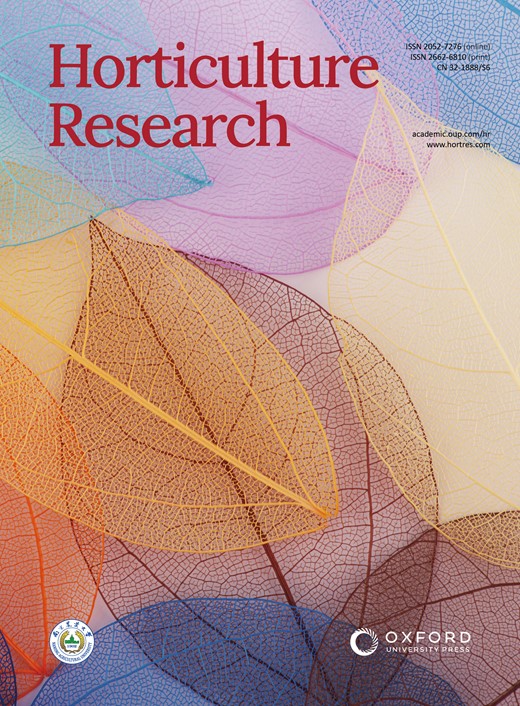MaASR3-MaHDT1模块通过抑制E3连接酶MaNIP1调节香蕉果实中高温抑制的叶绿素分解
IF 8.7
1区 农林科学
Q1 Agricultural and Biological Sciences
引用次数: 0
摘要
香蕉果实在超过24℃的高温下成熟会阻碍黄皮的形成,导致青熟,这大大降低了其适销性。我们最近的研究发现,HT诱导E3泛素连接酶MaNIP1 (NYC1相互作用蛋白1)介导的MaNYC1 (NON-YELLOW COLORING 1)降解抑制香蕉果实成熟过程中的叶绿素分解,但MaNIP1的上游调控机制尚不清楚。在此,与黄熟水果相比,在绿熟水果中被抑制的ASR转录因子(TF) MaASR3被确定为MaNIP1启动子的潜在结合蛋白。MaASR3通过抑制MaNIP1表达促进香蕉果实叶绿素降解。更重要的是,组蛋白去乙酰化酶MaHDT1与MaASR3相互作用,增强了MaASR3介导的MaNIP1的抑制。香蕉果实中过表达MaASR3降低了MaNIP1启动子的组蛋白乙酰化水平,抑制了MaNIP1的表达,从而减弱了ht抑制香蕉果实的去绿。我们的研究揭示了一个由MaASR3-MaHDT1-MaNIP1复合物组成的创新调控级联,它调节ht抑制的叶绿素降解。这解释了暴露在这种条件下香蕉的绿色成熟,并增强了对温度胁迫导致果实质量恶化的转录和表观遗传调控的理解。本文章由计算机程序翻译,如有差异,请以英文原文为准。
The MaASR3-MaHDT1 module modulates high temperature-inhibited chlorophyll breakdown in banana fruit by suppressing the E3 ligase MaNIP1
The ripening of banana fruit at high temperature (HT) exceeding 24 °C impedes developing yellow peels, causing green ripening, which considerably lowers its marketability. Our recent study found that HT induces E3 ubiquitin ligase MaNIP1 (NYC1 interacting protein 1)-mediated degradation of MaNYC1 (NON-YELLOW COLORING 1) to inhibit chlorophyll breakdown during banana fruit ripening, but MaNIP1's upstream regulatory mechanism is still unclear. Herein, the ASR transcription factor (TF) MaASR3, which is repressed in green-ripened fruit compared to yellow-ripened fruit, was identified as the potential binding protein for the MaNIP1 promoter. MaASR3 promoted chlorophyll degradation in banana fruit by repressing MaNIP1 expression. More importantly, the histone deacetylase MaHDT1 interacted with MaASR3 and enhanced MaASR3-mediated repression of MaNIP1. Overexpression of MaASR3 in banana fruit reduced the histone acetylation levels in the MaNIP1 promoter and repressed MaNIP1 expression, thereby weakening the HT-inhibited de-greening of banana fruit. Our study reveals an innovative regulatory cascade comprising the MaASR3-MaHDT1-MaNIP1 complex, which modulates HT-inhibited chlorophyll degradation. This explains the green ripening in bananas exposed to such conditions and enhances the comprehension of transcriptional and epigenetic regulations of fruit quality deterioration due to temperature stresses.
求助全文
通过发布文献求助,成功后即可免费获取论文全文。
去求助
来源期刊

Horticulture Research
Biochemistry, Genetics and Molecular Biology-Biochemistry
CiteScore
11.20
自引率
6.90%
发文量
367
审稿时长
20 weeks
期刊介绍:
Horticulture Research, an open access journal affiliated with Nanjing Agricultural University, has achieved the prestigious ranking of number one in the Horticulture category of the Journal Citation Reports ™ from Clarivate, 2022. As a leading publication in the field, the journal is dedicated to disseminating original research articles, comprehensive reviews, insightful perspectives, thought-provoking comments, and valuable correspondence articles and letters to the editor. Its scope encompasses all vital aspects of horticultural plants and disciplines, such as biotechnology, breeding, cellular and molecular biology, evolution, genetics, inter-species interactions, physiology, and the origination and domestication of crops.
 求助内容:
求助内容: 应助结果提醒方式:
应助结果提醒方式:


